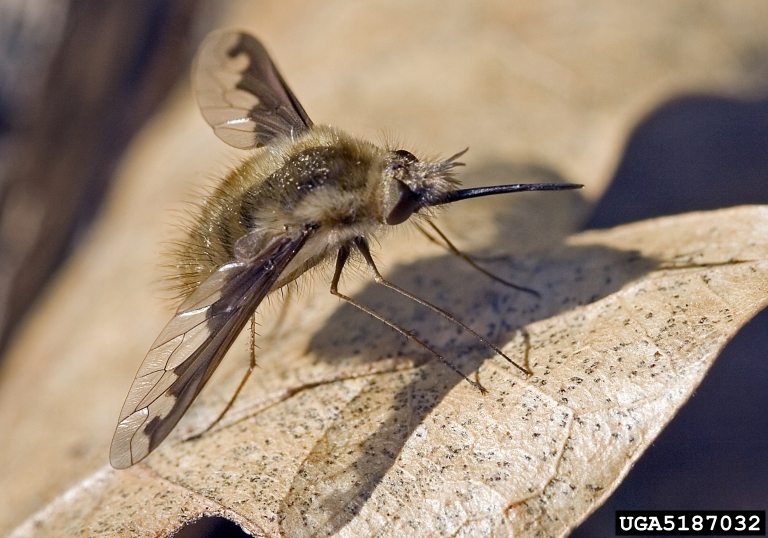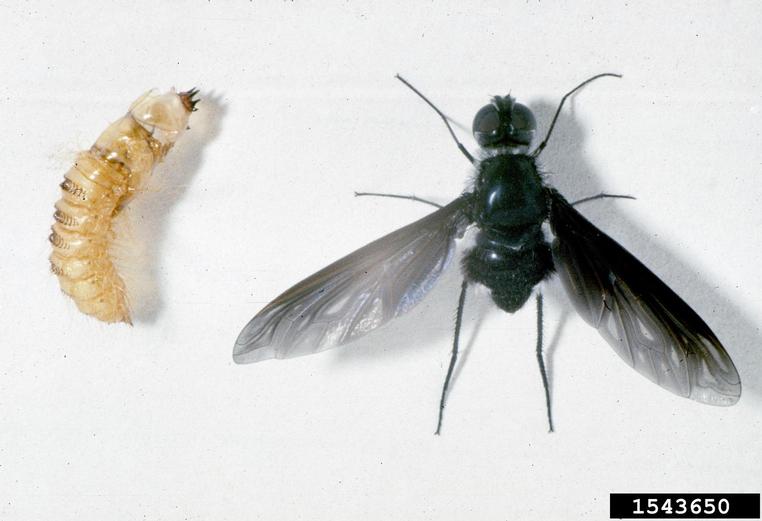 Bee Flies - September 10, 2014 Jeff Schalau, Agent, Agriculture & Natural Resources University of Arizona Cooperative Extension, Yavapai County Spending time in the garden can be truly amazing, especially where and when there are lots of blooming flowers. This summerís abundant rains have kicked flowering plants into a megabloom! Many insects are attracted to the nectar and pollen produced by summer blooming flowers. Sphinx moths, bees, beetles, butterflies and others come to the flowers looking for a meal. Some spiders wait on flowers for a flower-feeding insect. This season, I have observed lots of bee flies hovering amongst my flowers and thought it would be interesting to explore these often overlooked pollinators. If you donít look too close, a bee fly resembles a small bumblebee. Upon closer inspection, bee flies have a hairy body with long hairy legs with a long, slender tongue which they use to forage for nectar whilst hovering and darting amongst flowers. Speaking of hovering, bee flies are much more aerobatic in flight than bees and other winged insects. Bees have four wings and must land on a flower to forage. Bee flies (and other flies) have only two wings. Flies also have a pair of modified wings called ďhalteresĒ: knob-like structures which function like gyroscopes and give them greater maneuverability. Other characteristics of bee flies are large eyes, very short antennae, and many have a stiff and long proboscis, which they use for probing into flowers to sip the nectar while hovering in front of them. Bee flies also facilitate pollination of many species of flowering plants. While they do not land on the flower, they do carry some pollen from plant to plant. It is thought they are just as efficient pollinators of some types of flowers as are the bees and they are more frequent visitors so, in the end, they may a pollinate more flowers than bees. Bee flies are in the family Bombyliidae which consists of hundreds of genera Ė most of which have not been extensively studied. Being flies, they have complex (or complex) metamorphosis starting life out as an egg which hatches to become a larva (in flies itís called a maggot) and after feeding, it becomes a pupa where the larva undergoes changes to become an adult bee fly. This all sounds very simple and normal, but with the bee fly its lifecycle is not what youíd expect. Adult bee flies begin to fly in early spring as temperatures warm and flowers start to produce nectar. Many species of female adult bee flies have been observed laying or flicking their eggs into and near the nesting entrances of ground nesting solitary bees. Once in the tunnel, the egg hatches and the worm-like maggot crawls into an open host cell where it remains inactive until the host larva is about to pupate. The bee-fly larva then becomes a maggot-like ectoparasite and attaches to the outside of the host (the solitary bee larva), gradually sucking out the body fluids. The pupal stage is variable, but some will overwinter. The adults exhibit courtship rituals - males hover and exhibit territorial behavior which includes darting at rival males and spinning at females. Some species are known to parasitize other ground nesting insects such as wasps, hornets, beetles, grasshoppers, moths, butterflies, and flies. Insect biology can be much stranger than fiction. Iím not exactly sure which species of bee fly I see regularly in my garden, but I believe it is the greater bee fly (Bombylius major). Since Iíve seen so many bee flies this summer, I thought readers may have also noticed them and wondered about them. On the other hand, maybe I have too much time on my hands. Regardless, for the curious, Iíve included several bee fly photos and a couple of links below. Follow the Backyard Gardener on Twitter Ė use the link on the BYG website. If you have other gardening questions, call the Master Gardener help line in the Camp Verde office at 928-554-8999 Ext. 3 or e-mail us at verdevalleymg@gmail.com and be sure to include your name, address and phone number. Find past Backyard Gardener columns or provide feedback at the Backyard Gardener web site: http://cals.arizona.edu/yavapai/anr/hort/byg/. Additional Resources Bee Flies (Bombylius spp.), A Pollinator with a Bad Reputation USDA Forest Service www.fs.fed.us/wildflowers/pollinators/pollinator-of-the-month/bee_flies.shtml Bee-flies and False Widow Spiders Confound Public British Natural History Museum www.nhm.ac.uk/discover/news/2014/april/bee-flies-false-widow-spiders-confound-public.html Family Bombyliidae - Bee Flies (lots of photos and some description) BugGuide On-line Resource bugguide.net/node/view/185    |